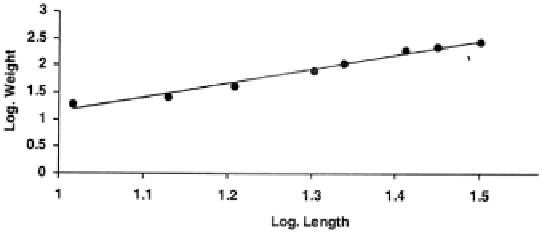Environmental Engineering Reference
In-Depth Information
Fig. 16.2
Logarithmic relationship
between the length and weight
of
Channa punctatus
from
Hussainsagar lake
Table 16.1
Average log length, average log weight, and
condition factor for various length groups of ishes from
Hussainsagar lake
Length
group (cm)
In the present investigation too, the experimental
ish disobeyed the cube law showing allometric
growth pattern. Several authors have assigned
various factors to be responsible for inluencing
the value of “
b
” and condition factor (
K
) in any
water body. These generally include nutritional
and biological factors like intensity of feeding,
state of maturity, sex, taxonomic differences,
competition for food and space, etc. (Srivastava
and Pandey
1981
; Zafar et al.
2003
). However,
since the present study was carried out in a
heavily polluted water body, i.e., Hussainsagar
lake, the ishes inhabiting in this lake are exposed
to frequent stresses caused by changes in tem-
perature, salinity, pH water velocity, sediment
loads, hypoxia, eutrophication, sewage, indus-
trial efluents, etc. The cumulative or synergistic
effect of these factors or stresses might have led
to the changes in the length-weight relationship
and condition factor of the ishes resulting in
abnormal growth pattern. The observed changes
may thus be attributed to the physiological
response of the ishes to different environmental
conditions of the lake waters.
Average log
length (
L
)
Average log
weight (
w
)
Condition
factor (
K
)
15-16
1.01703
1.27438
1.67220
17-18
1.13033
1.41229
1.09834
19-20
1.2 0951
1.60831
0.95448
21-22
1.30319
1.90374
0.98662
23-24
1.33845
2.02734
1.02796
25-26
1.41161
2.27943
1.10810
27-28
1.45024
2.34076
0.97726
29-30
1.50105
2.43697
0.85860
becomes less rotund as the length increases, and
the value of
b
> 3 represents that the ish becomes
more rotund as the length increases. In both the
cases, the dimensions of the ish change with
growth.Further,if“
b
” equals 3, growth may be
isometric (Allen
1938
) meaning that the ish
grows equally in all directions in the form of
cube, whereas if
b
> 3 or
b
< 3, growth may be
allometric (Grover and Juliano
1976
; Bagenal
and Tesch
1978
) meaning that the ish grows
unequally.
Condition factor (
K
) is an indicator of the
general well-being of the ish. In the present
study the condition factor showed continuous
declining values, i.e., from 1.67220 to 0.85860 in
successive length groups as seen from Table
16.1
.
Similar results were drawn by MacGregor (
1959
)
and Johal and Tandon (
1983
). MacGregor sug-
gested that if the value of exponent “
b
” is less
than 3, then the condition factor should decrease
with increase in size/age of ish. Further low
value of a condition factor is a deinite sign of
allometric growth (Kumar et al.
2006
).
References
Ali M, SalamA, Iqbal F (2000)Weight-length relation-
ship and condition factor of wild
Channa punctata
from Multan. Punjab Univ J Zool 15:183-189
Allen KR (1938) Some observations on the biology of the
trout (Salmo trutta) in Windermere. J Anim Ecol
7:333-349
BagenalTB,TeschFW(1978)Age&growth.In:Bagenal
TB (ed) Methods for assessment of ish production in
freshwaters, 3rd edn, IBP handbook No. 3. Blackwell
Scientiic Publications, Oxford























Search WWH ::

Custom Search